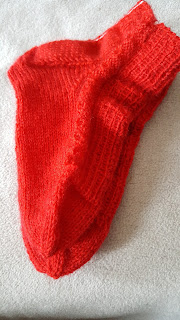I am using sock wool for needles size 3 mm and acrylic yarn for the soles. In all I pay 50 dkk (4-5 USdollars/ 7 Euros) for the materials. I tried to count the hours I use to make them. Not that it matters, because If I was supposed to charge at least minimum wages, they would not be able to sell anyways.... haha......
Here is the story:
First I make a pair of socks and add holes for the laces later, it is the first 10 hours.
Then I crochet "stripes" on the back and along the holes. Approx.1 hour
Then the soles. 2 hours
On the soles I knit the bottom edges and the tip of the toe. Before that I had to fasten all the yarn ends, another 2, 5 hours.
Then I attach the soles to the socks, first with some fine stitches along the edges in front and after that the rest of the sole with sewing thread in order to make the seam invisible. 1 more hour
Finally I can see the light at the end of the tunnel, only the logos and the laces left to make, yet 45 minutes.
Finally..........well even putting the laces in takes 15 minuttes.
I all I have used 17,5 hours on a pair of Converse sneakers/slippers.
But I have enjoyed myself, so when I sell them in Denmark I have chosen only to charge 200 DKK (35-40 USD or 28 EUROS).
Which means, that more people are happy about their new slippers
( ps. As I have a lot of experience I better warn you if you are new to this, count on at least 5 - 8 extra hours work. The pattern is found here on the net)































































